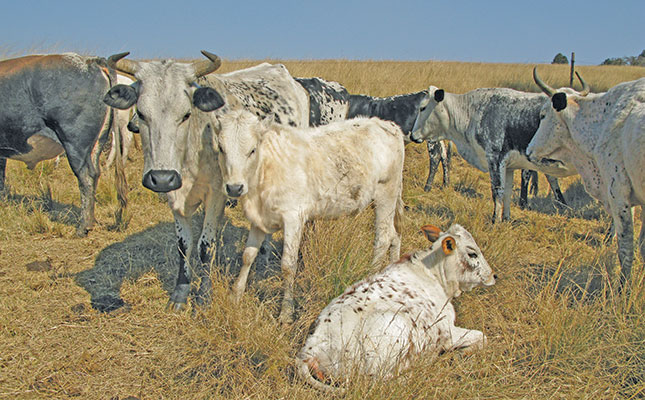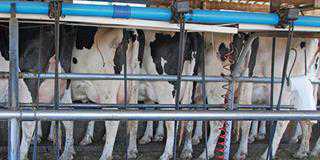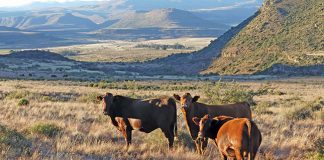
Photo: FW Archive
Long- and short-term climatic patterns influence all livestock types: poultry, pigs, sheep, goats, dairy and beef cattle and others. Extreme environmental conditions, such as cold and hot conditions due to air temperature, thermal radiation, humidity and wind speed, cause stress and suboptimal animal performance, which lowers productivity.
With beef cattle in the Northern Cape and North West in particular, but also in parts of KwaZulu-Natal, heat stress is known to be a major source of production losses.
The temperature-humidity index
Globally, the level of heat stress is measured with different indices. In South Africa, the temperature-humidity indices of the South African Weather Services (SAWS) for different species of livestock are the broadly applicable formulas used to assess the impact of extreme weather on livestock.
The index is a measure of apparent temperature, caused by the combined effects of air temperature and relative humidity on the subjective perception of heat and humid weather. Wind speed can be an aggravating factor. These handy tools can be used for risk management of heat stress and may prevent adverse effects.
The temperature-humidity index (THI), for beef cattle particularly, is calculated as follows:
THI = 0,8 + RH*(Ta – 14,4) + 46,4 where RH indicates relative humidity and Ta indicates dry-bulb temperature.
Although there are several categorisations of heat stress indices, SAWS has categorised the livestock weather safety index as ‘normal’ under 74, ‘alert’ between 74 and 79, ‘dangerous’ between 79 and 84, and ‘emergency’ when above 84.
It is plausible that higher humidity equates to higher effective temperature at lower thermometer readings, putting animals into heat stress at a lower environmental temperature.
For example, the THI for a stable body temperature in which beef cattle can regulate their temperature with metabolic processes is approximately 30°C, when the relative humidity is below 80%, but only 27°C when the relative humidity is above 80%.
The Northern Cape and North West are well known for their extensive commercial livestock and game farming operations in inland areas. These provinces are prone to extreme climate events because of their geographic locations, and the agriculture sector here is highly vulnerable to climate change.
The ‘Climate change status quo report for the Northern Cape province’ (2015) states that in this province, as well as in parts of other provinces, the rainy season is likely to shift to later in the year and be of shorter duration, and the dry spell is likely to increase in length, resulting in drought, with negative implications for agriculture and water supply. The magnitude of heat stress is also expected to be severe.
As for the effect of temperature alone, it was established that for every 1°C that daytime temperatures exceed 30°C, most breeds and varieties of livestock reduce their feed intake dramatically.
In some cases, feed intake has been observed to decrease 5% per 1°C above 30°C. Reduced feed intake reduces productivity in all forms of livestock, and how an animal responds to heat stress may well come to influence farmers’ breed selection.
Breed, frame size and production level also affect animals’ biological responses to stressors. The efficiency of beef cows differs according to their fertility and milk production levels.
Moreover, heat-stressed beef cows experience gestation lengths of about four days less than average, are more prone to anoestrus-induced abortion, produce calves with lower birthweights and growth rates, and have poorer-quality colostrum. Heifers also have delayed puberty.
Sanga vs European sires
Crossbreeding research at the Vaalharts Research Station where Sanga (indigenous or locally developed), Afrikaner, Bonsmara and Nguni cows were mated with Afrikaner, Bonsmara, Nguni, Angus and Simmentaler bulls, was conducted during the 2015/2016 and 2016/2017 summer seasons.
The 2015/2016 summer was the hottest and driest year ever recorded in South Africa. In the preceding nine summers, there had been on average 1,9 heatwaves per summer with 6,5 heatwave days. The 2015/2016 summer saw 12 heatwaves with 71 heatwave days.
The 2016/2017 season, however, was wetter and cooler. Post-weaning growth (average daily gain) of weaner bulls for the two consecutive years was recorded every seven days under feedlot conditions.
The results showed that Sanga-sired calves (Afrikaner, Bonsmara and Nguni) and Angus/Simmentaler-sired calves had the same 205-day corrected weaning weight (171kg) in the 2015/2016 season, but 183kg and 210kg corrected weaning weights for Sanga and British/European-sired calves respectively (see table).

The very dry and hot 2015/2016 season also had an effect on the post-weaning growth of these cattle breeds.
The average daily gain of the Angus-Simmentaler calves decreased 17%, whereas that of the Sanga types decreased 9% as the result of the heatwaves.
As far as weight traits are concerned, the severe drought and extreme heat had a greater effect on the exotic breed types.
But it is also widely accepted that indigenous breeds with small to medium body sizes are hardier, more fertile and uniquely adapted to harsher environments, unlike larger exotic breeds. For this reason, it should be remembered that some breeds may regulate their body temperatures well and have the ability to resist heat stress, but their productivity may nonetheless be lowered.
Therefore, the best long-term solution to heat stress is to use cattle that are genetically adapted to cope under these conditions.
Other contributors: MM Seshoka, MM Scholtz, GM Pyoos-Daniels and M Mengistu.
For more information, email Anette Theunissen at [email protected].













